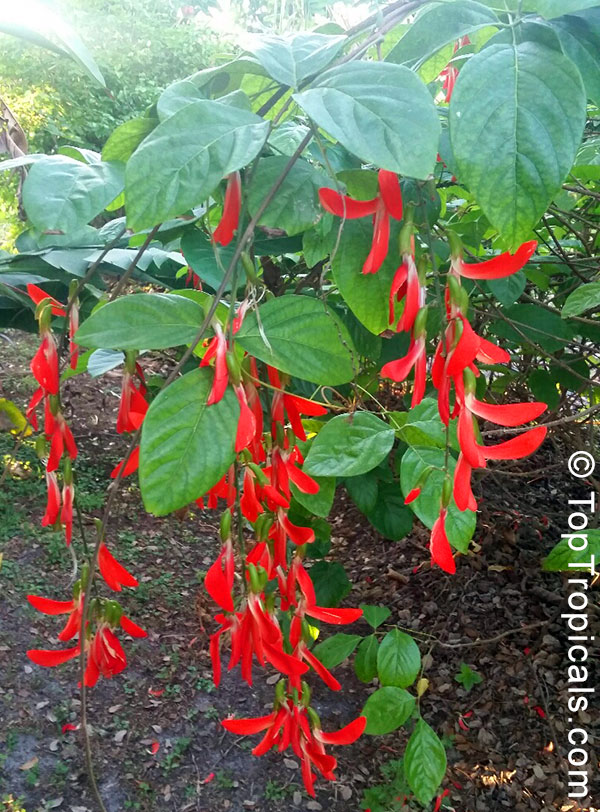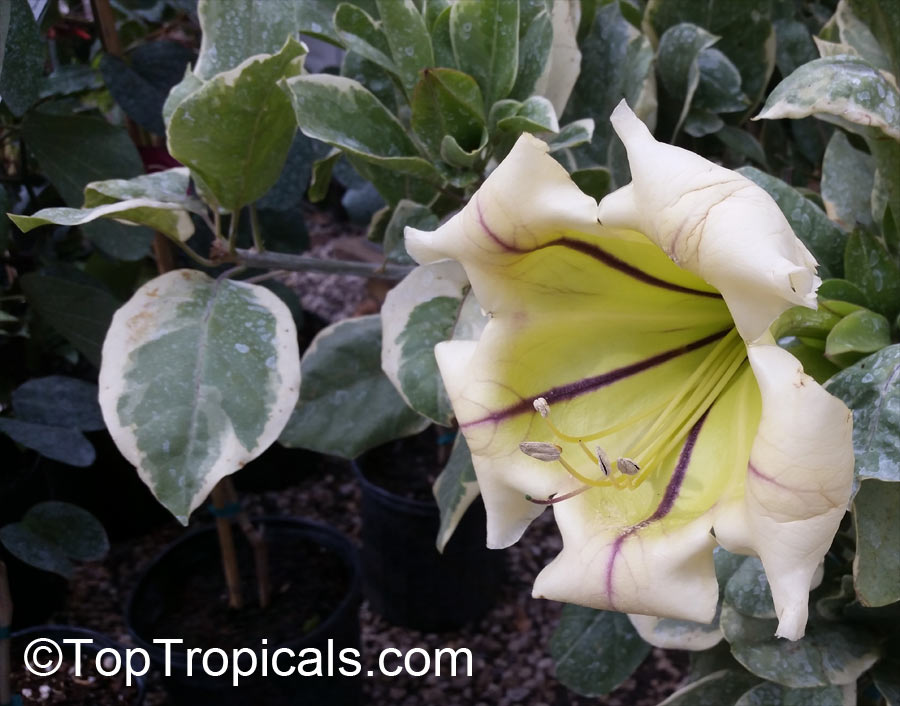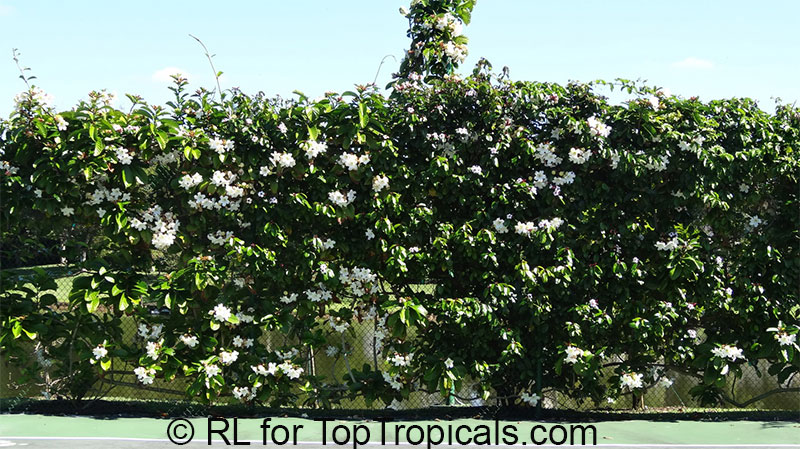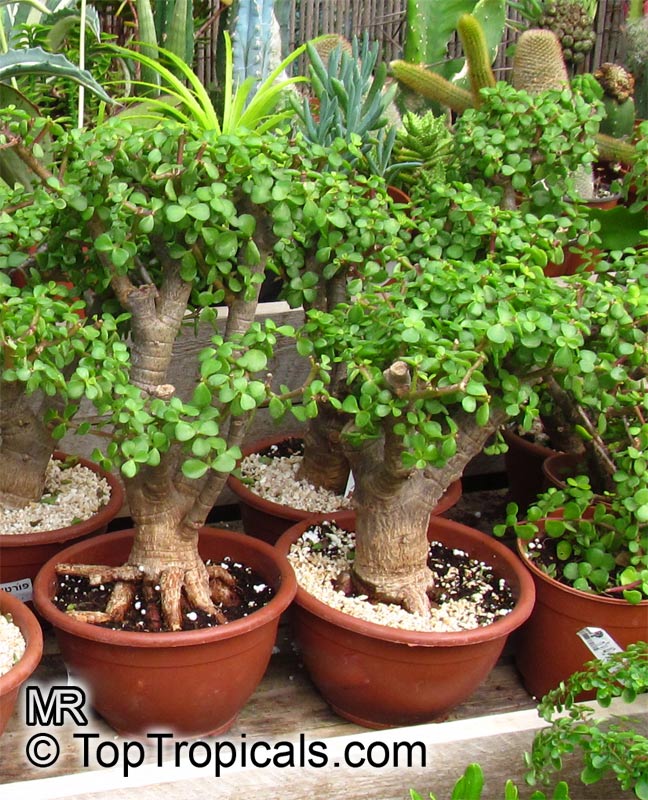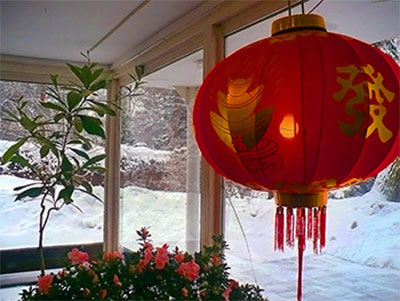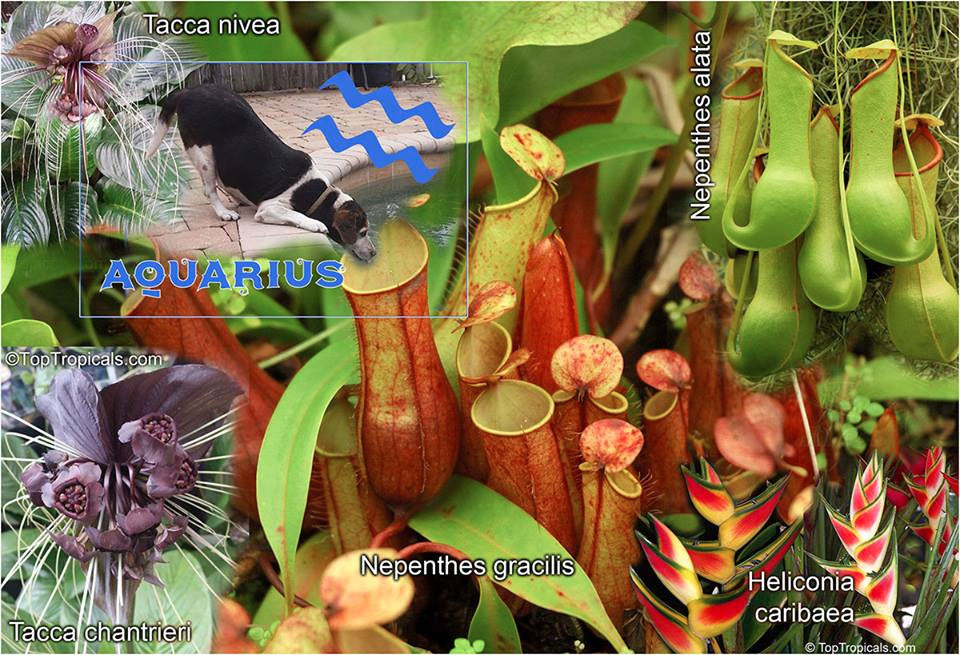Garden Blog - Top Tropicals
Date:
Featured plant.Camptosema grandiflora - Dwarf Red Jade Vine
Camptosema grandiflora - Dwarf Red Jade Vine
Dwarf Red Jade vine. If you always wanted to own THE Red Jade Vine, here is your chance! Also called Cuitelo, Crista-De-Galo (Rooster's Crest), it is sometimes miss-identified as a Mucuna species. This amazing eye-catcher is closely related to Red Jade Vine, however, it is much hardier than the ultra-tropical Mucuna benettii! It is a spectacular fast-growing vine from Brazil with long pendulous chains of fiery bright red flowers. Heavy vine, it needs large trellis or pagoda. An arbor is ideal so that the brilliant flowering racemes can hang down from the ceiling. Blooms in fall and winter. Prune heavily in spring after flowering. Give full or partial sun with adequate moisture and fertilizer. It is very easy to grow, can tolerate some drought and light frost.
Date:
Mucuna nigricans - Black Jade Vine
Black Jade Vine is a real gem of a rare plant collection and a
conversation piece when in bloom. The flower color is beyond description, as most of
the Jade vines. This spectacular woody climber is closely related to red Jade
vine (Mucuna bennettii). Branches sparsely velvet-hairy, and blackish purple
flowers hanging in racemes. Drooping flower-cluster-stalks are up to 1 ft
long and 6" in diameter! The blooms appear closely pushed together in grape-like
clusters. Flowers are clustered in threes; each cluster supported by a
deciduous bract. It is a very vigorous woody tree creeper - during warmer weather
it can grow 2 feet or more a week. Cold hardy in Florida to at least zone 9b.
This plant is a must for every rare tropical plant collection. It is
easy to grow and doesn't require much care once established other than regular
watering. In colder climates with a hard freeze, this spectacular vine can be
grown in a large container providing a strong trellis support.
Date:
Impossibly exotic Chalice Vine
By Onika Amell, our flower specialist
Q: I live on Sanibel Island, Florida and I'm looking for an exotic vine to cover the side of my house. A friend suggested Chalice vine. What can you tell me about it and will it tolerate the salty soil and salt spray of the island?
A: Chalice vine, or Cup of Gold - Solandra maxima - is a large,
woody, scrambling tropical vine with huge, cup-shaped flowers. Variety
Variegata has also amazing cream and green variegated foliage. The flowers are
fragrant, especially in the evenings, with a lovely coconut-like aroma. This
unusual vine will give you intermittent waves of large, wide flaring golden
trumpets.
Even when not in flower, it is beautiful as new growth is bright and
purple-bronze in color. It has a large and loose spreading habit. As this vine
ages, flowers will appear along the entire length of branches off the main
vine. So, just think about it - up to 100 feet vine and you will have about 500
flowers at the same time! They are very fast growing and usually bloom from
February until May. Plant them... Sit back and wait... Four months of heaven!
They are great for seaside gardens as they are very tolerant of salt
spray and salty soils. Will, in fact, thrive in most any well-drained soil.
Give it a large, sturdy pergola or trellis, or train it to grow up the
side of a house where it will spill down over windows and doorways to take
your breath away... Chalice vine is impossibly exotic!
Date:
Vigorous flowering vine for a large trellis
Q: I am looking for a suitable vine for my home. The wall/trellis which I would like to plant the vine(s) is a two-story wall. The area gets lots of light at midday but not direct sunlight. Most of the light comes from the north. Our home is in South Florida (Miami). Would you please suggest a lovely colorful vine(s) that would flower well under these conditions? Maybe one that has fragrance.
A: Below
are some of our suggestions for your project. These flowering vines are
vigorous, fast growing, tolerant of part-sun conditions and still, will produce
flowers for you to enjoy:
Clerodendrum speciosum
Clerodendrum thomsoniae - Bleeding Heart
Jasminum humile - Italian jasmine - fragrant
Jasminum nitidum - Star Jasmine - fragrant
Mansoa alliacea - Garlic Vine
Pyrostegia venusta - Flame Vine
Quisqualis - Rangoon Creeper, Thai Double Flower - fragrant
Thunbergia laurifolia - Blue Sky vine
Urechites lutea - Yellow Mandevilla
Beaumontia murtonii - Nepal Trumpet Flower
- this one has large fragrant flowers and large tropical leaves...
See very interesting story about Beaumontia live fragrant wall.
Check out all vines from our selection and vigorous growers for large areas like fences and big trellises.
Date:
Fascinating Spekboom (Portulacaria afra, or Baby Jade)

By Mark Hooten, the Garden Doc
...I love this plant! I first grew it in the 1960s when I was just a
kid. I found it growing as a fantastic four-foot tall houseplant in a big sunny
window in a schoolmate's home and was happily given a cutting. When I
inquired about this most unusual plant, my friend's mother explained that she had
brought a piece of it with her when she came from South Africa many years
earlier. She told me that in Africa, it is a favorite food for both Elephants and
Rhinoceros and that it was grown all over her families farm for feeding both
animals and people. Being a little kid in Illinois, I found this especially
fascinating...
Continue reading...
Date:
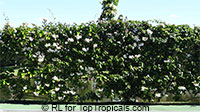
Easter Lily Vine creates a fragrant privacy fence of virtually unlimited size
By Ron, South Florida. Easter Lily Vine (Beaumontia grandiflora) is a magnificent woody evergreen climber of unlimited growth potential. A branch of this vine will grow simply until you cut it. I have branches of up to 30 ft. and longer.
I've used two plants to turn a chain-link fence into a privacy screen that is 40 ft. wide by 10 ft. tall, but even a single plant can cover a much wider space if trained properly.
Easter Lily Vine's growth rate is moderate, so it doesn't require constant pruning to keep under control like other vigorous vines. I bought mine in 7 gallon pots, and planted them in the ground immediately. It took about 2 years to completely cover the fence. Since then, I prune it 3-4 times a year.
Keep in mind that these plants are heavy and require a solid structure as support. They twine by nature, but only around items with 3†diameter or more. Mine twined around a near-by lighting pole!
The absolute key in training Easter Lily Vine is to force it to grow horizontally. I recommend planting a young 3 gallon size vine in the ground diagonally, so it grows horizontally. Tie it no more than a foot above ground and let it grow a single branch until the end of the space you want to cover. Then force it to make a U-turn and let it grow the other way. See the following diagram for illustration..
.See step-by-step full size pictures and the rest of the article...
Date:
Top Tropicals New Year Resolutions
We take this opportunity to extend our grateful thanks to all visitors and friends of our garden and website. The entire Top Tropicals team wishing you a Happy New Year with Happy New Plants!
In 2019, Top Tropicals plans include (but are not limited to):
- improved design of the website, online store and shopping cart
- many new introductions of rare flowering plants including Red Jade
Vine, lots of new Adeniums
- rare fruit trees, including Mangosteen, Nutmeg, Clove and more
- extended selection of rare tropical seeds
- many new videos of rare tropical plants
- free and discounted shipping
Stay informed with our Newsletter updates!
New Year Resolutions for Gardeners in 2019
January is the month to plan and dream about your yard and garden. Grow
your garden a few steps at a time each year: pick a few resolutions for 2019
and plan accordingly. Next year, a few more, and so on until you build the
garden of your dreams.
This winter, resolve to:
- Hang a bird feeder.
- Order seeds of some rare plants so you can have an early start.
- Prune a tree into an espalier - it's a perfect time before Spring.
- Ask your grandparents what they grew in their gardens.
- Build a raised bed for succulents.
- If you live in a warm climate, plant a fruit tree or two.
- Start a compost pile.
- Plant a palm tree.
- Try some plant boosters to improve your plants hardiness.
- Chose Flowering trees, shrubs and vines suitable for areas in your garden that still have room...
- Install a rain barrel.
- Eat outside as often as possible.
- Show a child how to plant a tree.
- Provide a water source for bees and butterflies. They are not only
cool, but also pollinators that will help to set fruit and seeds!
- Call TopTropicals for garden advise - what to plant, where to plant,
and how not to kill it!
- Plant a berry-bearing tree or shrubs to feed the birds. Mulberry, Blackberry, Tropicals Cherries - are always good choices. They are 15% OFF now, offer expires 1/8/19.
- Rake and save fallen leaves for winter mulch for your garden beds.
- Save seeds from flowers to plant next year.
- Give plants as gifts all year long.
Happy gardening in 2019!
Date:
How to get Passion Vine to flower?
From Mark Hooten, the Garden Whiz
Q: Several months ago, I purchased a passionflower vine, a red one with lots of flowers. I ended up putting it in a much larger pot with a large trellis, using a popularly advertised bagged potting soil recommended at a big box store. I have given it a blue colored water-soluble fertilizer every couple of weeks as recommended. However, while the vine seems very happy, growing faster than i can keep winding it around the trellis, it has not flowered all summer. I there something I am doing wrong?
A:
Passionvines as a group (and there are some 500 different kinds!) are sort-of
unusual among popularly grown ornamentals because they have "nitrogen issues". This
is because, even though unrelated, they are much like most legumes, as they
maintain a symbiotic relationship with certain beneficial soil bacteria which
allows them to gather atmospheric nitrogen and store it in their roots. When
they have an overabundance of nitrogen, they simply stop flowering and
produce rampant leafy growth while never flowering. They only flower well after a
period of healthy vine growth, because the plant had finally used up all of
its stored nitrogen.
Since you had both used a bagged potting soil which likely already
contained fertilizer with nitrogen added, as well as bi-monthly doses of a liquid
fertilizer which also contains nitrogen, it has been receiving so much
nitrogen it only knows to grow more vineage until the nitrogen is used up. If and
when that happens, it will again begin to flower. This rule applies of course
not only to flowering but also to fruiting varieties of Passiflora: the more
flowers, the more fruit you get!
So the answer is - for the time being, just stop giving it supplemental
fertilizer and it will start flowering for you sooner than later!
See all passion vines from TopTropicals.
Date:
Aquarius Zodiac lucky plants

Aquarius - 1/22 - 2/18.
Aquarius is an AIR sign ruled by odd-ball Uranus.
The water-bearer's plants will often grow in unusual places and may vary in appearance. They often have purple or blue flowers, or may have unusual colors.
The most healing and beneficial plants for Aquarius are the ones that help circulation, relax the nervous system, or promote inspiration. When Uranus was discovered, it replaced Mercury as ruler of Aquarius. Physiologically, Uranus rules the bioelectrical impulses that power the body's nervous system (nervous tension and nervous exhaustion brought on by powerful changes in the environment are related to both Mercury and Uranus). Physically, Aquarius rules the lower legs, the calves, and the ankles, and the electrical impulses that travel through the body's nervous system. The nervous system itself is ruled by Mercury, and Uranus is said to be a "higher octave" of Mercury. Since Uranus was discovered after the correspondences with plants had been established, the herbs used in Aquarius are Mercury herbs. Always difficult to pinpoint, quirky Aquarius appreciates the unusual and complex flavor of star anise. Use this star-shaped spice when you wish to bring happy surprises into your life.
Aquarius Zodiac lucky plants:
Anise, Orchid, Golden rain - Koelreuteria paniculata, Bird of Paradise, Heliconia, Petrea, Mandevilla, Jasminum, Kiwi, Persimmon, Loquat, Olive, Alocasia, Colocasia, Citrus, Apple, Peppers, Gingers, Carambola, herbs spicy with an unusual flavor, White Pothos, Ivy, Shami - Prosopis cineraria, Neem, Medinilla, Sheesham Tree, Catnip, Passion fruit, Valerian, Aloe, Myrrh, Kava-kava, Cinnamon, Clove, Eucalyptus, Coffee, Cola nut, Nepenthes, Vanilla Orchid, Strongylodon - Jade vine, Tacca - Bat Lily, Eranthemums, Agapanthus, Orchid trees, Bolusanthus, Chamaedorea metallica, Clerodendrum ugandense, Clitoria, Duranta, Guaiacum, Jacaranda, Lavanda.
For other signs information, see full Plant Horoscope.
New Video: TopTropicals at TPIE show in Ft Lauderdale. Last week, your friends at Top Tropicals attended the 2017 Tropical Plant International Expo in sunny Ft. Lauderdale Florida. The Expo was an opportunity for Top Tropicals to introduce our SUNSHINE in a Bottle plant boosters as well as to bring a very rare plant Enchanted Incense to the tropical plant market!
Check out this video: TopTropicals at TPIE.
Stay updated with TopTropicals Videos by subscribing to our channel at YouTube.com/TopTropicals and get our latest video news of what's fruiting and blooming!
Date:
Aquarius Plant Horoscope

Aquarius - 1/22 -
2/18.
Aquarius is an AIR sign ruled by odd-ball Uranus.
The water-bearer's plants will often grow in unusual places and may vary in
appearance. They often have purple or blue flowers, or may have unusual
colors.
The most healing and beneficial plants for Aquarius are the ones that help
circulation, relax the nervous system, or promote inspiration. When Uranus
was discovered, it replaced Mercury as ruler of Aquarius. Physiologically,
Uranus rules the bioelectrical impulses that power the body's nervous system
(nervous tension and nervous exhaustion brought on by powerful changes in the
environment are related to both Mercury and Uranus). Physically, Aquarius
rules the lower legs, the calves, and the ankles, and the electrical impulses
that travel through the body's nervous system. The nervous system itself is
ruled by Mercury, and Uranus is said to be a "higher octave" of Mercury. Since
Uranus was discovered after the correspondences with plants had been
established, the herbs used in Aquarius are Mercury herbs. Always difficult to
pinpoint, quirky Aquarius appreciates the unusual and complex flavor of star anise. Use this star-shaped spice when you wish to bring happy
surprises into your life.
Aquarius Zodiac lucky plants:
Anise, Orchid, Golden rain - Koelreuteria paniculata, Bird of Paradise, Heliconia, Petrea, Mandevilla, Jasminum, Kiwi, Persimmon, Loquat, Olive, Alocasia, Colocasia, Citrus, Apple, Peppers, Gingers, Carambola, herbs spicy with an unusual flavor, White Pothos, Ivy, Shami - Prosopis cineraria, Neem, Medinilla, Sheesham Tree, Catnip, Passion fruit, Valerian, Aloe, Myrrh, Kava-kava, Cinnamon, Clove, Eucalyptus, Coffee, Cola nut, Nepenthes, Vanilla Orchid, Strongylodon - Jade vine, Tacca - Bat Lily, Eranthemums, Agapanthus, Orchid trees, Bolusanthus, Chamaedorea metallica, Clerodendrum ugandense, Clitoria, Duranta, Guaiacum, Jacaranda, Lavanda.
For other signs information, see full Plant Horoscope.
